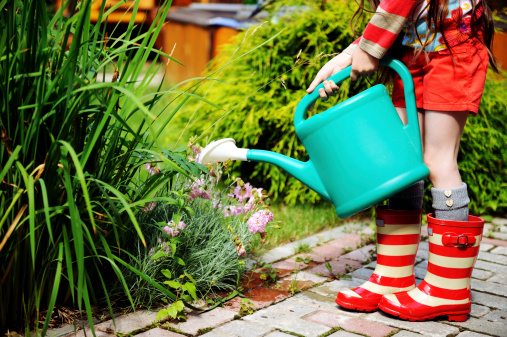Everyone you speak to (the elderly woman at the bus stop, the father out with his kids) is sick and tired of seeing the wasteland and wants a nicer, cleaner, more pleasant shared space… Time for some guerrilla gardening!
What is guerrilla gardening?
Wikipedia describes it like this: “Guerrilla gardening is the act of gardening on land that the gardeners do not have the legal rights to utilize, such as an abandoned site, an area that is not being cared for, or private property.” Although it started to take root during the hippie era of the 1960s, there are records of guerrilla gardening dating back to the 17th century when a group called The Diggers fought for the right to cultivate land. Some of the earliest famous guerrilla gardening projects took place in New York in the 1970s – Liz Christy coined the term ‘guerrilla gardeners’ when she transformed a derelict lot into a flourishing garden, called the Bowery Garden. She offered gardening workshops and planted flowers, trees and vegetables whilst petitioning the city’s Housing and Preservation Department to recognise the area as an official community garden. Theirs was a success story, and the area remains today, tended to by volunteers. Another 1970s act of guerrilla gardening was Adam Purple’s yin-yang-shaped garden in Manhattan. Sadly, it was bulldozed by the City of New York, but not before it had reached 15,000 square feet. A short film, Adam Purple and the Garden of Eden, tells the story.
Isn’t it illegal?
Well, yes. But that doesn’t stop people reclaiming their public spaces and making them beautiful for everyone to enjoy. Many guerrilla gardeners are activists, fighting back against the homogenisation of our cities and the lack of green and shared spaces. Others are simply trying to brighten up a barren-looking patch of earth. Looking at guerrilla gardening forums, lots of gardeners find that the police tend to turn a blind eye to this kind of activity as long as the perpetrators don’t draw attention to themselves. Most gardeners choose to carry out their guerrilla action under the cover of darkness. That’s not to say that once the gardens are flourishing they are safe. Sadly, far too many beautiful and productive community gardens have been bulldozed to make way for convenience store giants like Tesco and Sainsburys. But guerrilla gardeners refuse to give up and once a garden has become established, they often actively petition to keep it that way.
How can I find out more?
Those keen to get involved in guerrilla gardening will find Richard Reynolds’ website www.guerrillagardening.org a veritable treasure trove of tips and information. The website started life in 2004 as a blog covering Reynolds’ solo guerrilla gardening outside a block of flats near Elephant and Castle in London. Now, it has visitors from all over the world who post tales of their own exploits including photos of the various locations they have rejuvenated. There’s a community area for budding guerrilla gardeners to join, and plenty of advice for those just starting out. Reynolds is now recognised as Britain’s 24th most influential gardener and he was asked to write a book – On Guerrilla Gardening, a handbook for gardening without boundaries – is the result.
What shall I plant?
It depends how big the space is. Plants that can cope with droughts and poor soil and those that provide year-round colour or visual impact are best. There is further information online on the best plants to choose. Many believe it is best to stick with local plants and that’s where local wild flower mixes can come into their own, as these species can cope with poor soil and take hold in otherwise barren landscapes. Garden centres and nurseries might offer reduced or end of line plants if you talk to them about the area you’d like to brighten up – many guerrilla gardeners have found them to be surprisingly helpful. Other resources include budget plant offers in DIY stores or seed-swapping with local gardeners. This is probably the best way to go about guerrilla gardening as it’s free and keeps the essence of the project in mind. You don’t want to fork out for loads of tender seedlings only to watch them die or see them bulldozed a few weeks later. Perhaps one of the most familiar guerrilla gardening terms is ‘seed-bombing’, when gardeners create ‘grenades’ or ‘bombs’ of compost and seeds and throw them into derelict or neglected land. This type of gardening works best when there is no direct access to the land and again wild flowers are ideal as it is then difficult or impossible to water the seeds. To find out how to make a seed bomb, check online for instruction videos like this one here.
1st May is Sunflower Day!
This international guerrilla gardening day takes place annually on 1st May, and this year sees its eighth manifestation of sunflower planting. Guerrilla gardeners across the world are invited to sow sunflower seeds wherever they see a patch of barren land. Keen activists can get hold of free sunflower seeds on the guerrilla gardening blog by emailing Richard Reynolds. So have a look around your locality and see where an area could be brightened up by a smiling sunflower face…
If you’re planning on brightening up a big patch of land, it’s worth getting a group of people together to help out – the more the merrier. A lot of guerrilla gardening involves clearing an area of rubbish and rubble so protective gear (gloves especially) and sturdy shoes plus strong bags to dispose of the rubbish in are important. Some really barren land needs a fair bit of TLC before it is ready for planting and that’s where plenty of willing gardeners makes all the difference. Before you get started on your guerrilla gardening project, check out Richard Reynolds’ 12 tips for getting your vision off the ground.
Go forth and sow beautiful landscapes!







